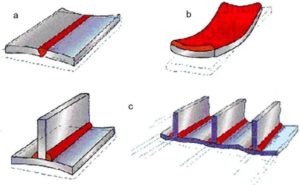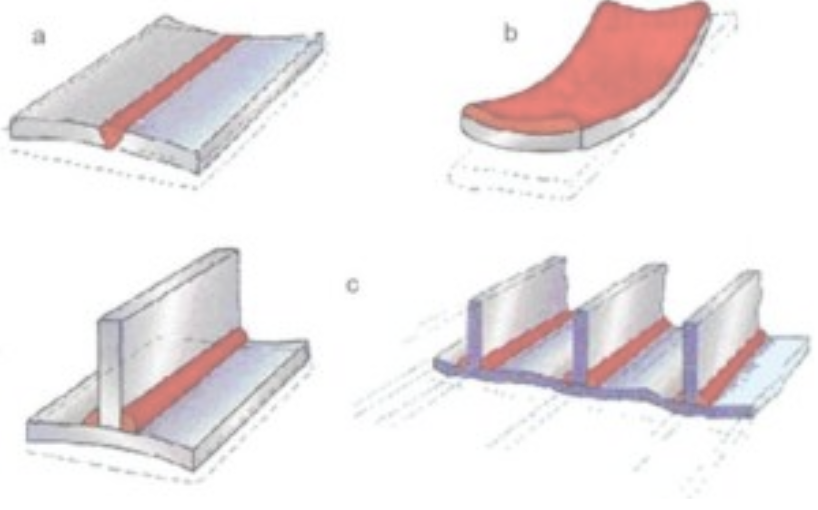As we mention in one of our earlier articles, welding described as a process of attaching two metals through the agency of heat or pressure in addition to the filter material. During the welding process lack of practice and preparation, or being careless may cause some weld defects. Whatever the reason is, these defects lead to production disruptions and time losses for reprocessing the part that has weld defect. Even experienced welders compete with weld defects such as weld distortion, which is unwanted expansion or contraction in workpieces, as a consequence of the welding process. Today we will demonstrate the main cause of weld distortion, types of distortions, how to prevent it and finally how to correcting it.
What are weld distortion and its types?
The welding process requires highly concentrated heating of the joint edges to merge the workpieces. Due to the expansion and contraction of heated and cooled material, non-uniform stresses are formed.
Firstly, compressive stresses are produced when the weld pool is formed in the surrounding cold parent metal due to the thermal expansion of the hot metal (heat-affected zone) adjacent to the weld pool. During the cooling, tensile stresses occur on weld metal and heat-affected zone. The volume change in the welding area during solidification can show the magnitude of the thermal stresses induced into the material.
When the stresses produced by the thermal expansion/contraction exceed the yield strength of the metal parent, plastic deformation occurs. Plastic deformation causes a permanent reduction in the dimensions of the workpieces and distorts the structure and shape. The shape and rate of the distortion depend on several factors; material type, the geometry of the workpiece, weld design, heat input, welding procedure, part fit-up, amount of restraint, and so on.
Transverse Distortion
It is the extraction of the weld metal that occurs in the direction perpendicular to the welding seam caused by the transverse stresses, during cooling. Since hot weld metal has lower yield strength than cold plates, deformation firstly occurs at welding. Nevertheless, deformation of the base metal may also happen at the end of cooling. This deformation causes a reduction in the width of the base metal.
Longitudinal Distortion
Figure 1 (b) shows the most common distortion; longitudinal distortion is shrinkage stress which results in shortening along the length of the weld bead. Longitudinal shrinkage is maximum along with the weld bead and decreases away from the bead.
Angular Distortion
The angular distortion comprises the rotation of the structure around the welding line. It is a special form of transverse distortion, so when transverse shrinkage is not uniform in the thickness direction, the angular distortion occurs in a butt joint. The major factors altering the development of angular distortion are: material properties (thermal conductivity, thermal expansion coefficient, specific heat), welding procedures (welding current, arc voltage, welding speed, shielding gas chemical composition, gas flow rate, welding gun angle)
weld groove geometry, joint type).

Figure 1. Transverse (a), Longitudinal (b), Angular (c) distortion
Minimizing the Weld Distortion
Although the weld distortion or shrinkage does not completely prevent, it can be controlled by the changing of welding time, positioning the weld, changing the weld metal amount. Let’s examine minimizing the weld distortion in detail.
- Correctly sizing the weld metal: The more weld metal that is put in the joint, the more shrinkage can occur. Sizing weld metal correctly to meet the joint conditions, minimizes the distortions and conserve the weld metal and time. By using a flat or convex bead with proper edge preparation in a butt joint, the amount of weld metal in a fillet weld can be greatly reduced. Using excess weld metal increase the shrinkage forces.
- Intermittent Welding: As we mention, excess weld metal increase the shrinkage forces, to minimize shrinkage forces another chance is to minimize weld metal. Applying intermittent welding instead of continuous welding reduces weld metal and therefore minimizes the shrinkage forces.
- Using less weld passes: When many passes are used, total shrinkage can be increased. If there is a possibility to occur transverse distortion, instead of using large electrodes, using small electrodes with more number of passes prevent the distortion.
- Put welds close to the neutral axis and balance welds around it: Design of the workpieces, weldment, and welding arrangement must be suitable to control distortion. Welding near the neutral axis of the workpiece minimizes the distortion due to lessening leverage for shrinkage forces to drag the plates out of alignment.
- Backstep welding: Backstepping is a great way of limiting distortion for thin sheet metal welding, but it increases time cost and time. It is a welding technique when the direction of welding is in one direction but the overall travels backward slightly into the deposited weld.
- Minimize the welding time: Heating and cooling cycles are the main causes of distortions. The time factor affects distortion as convoluted heating and cooling cycle during the welding process, due to it is required for heat transmission. Generally, the faster welding process result in less volume of surrounding metal heats up and expand.
Correcting the distortion after it has occurred
Despite all these warnings and precautions above, weld distortion can occur. Mechanical and thermal methods can be used to correct weld distortion even though it can be time and money consuming. The key mechanical remedies for weld distortion are hammering and pressing. In order to push distorted areas flat; mechanical straightening involves the use of force to press distorted areas flat with a hammer, pneumatic ram, pressing machine, or similar machines. If mechanical remedies for weld distortion is not suitable for our workpieces, thermal methods can help to correct the distortion. Heat produces local stresses which are reasonably great to our workpiece are pulled back into when it cooled. The following methods are applied to this technique,
- Line heating: Heating the workpiece in a straight line along the welded joint on the opposite side of the weld. This technique is generally used for correcting angular distortion.
- Wedge-shaped heating: This method can be used in larger complex fabrications. Wedge shapes are heated to correct distortion.


